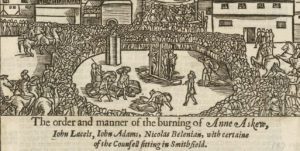A simple recipe for a sermon is to identify the big idea in the passage and then communicate that in the sermon. But like all simple recipes, this approach has its flaws that maturing preachers and listeners alike should know about.
The form and substance of a faithful expository sermon, it is widely agreed, should be the ‘big idea’ of the biblical text being preached. This approach was advocated for by Haddon Robinson’s excellent book Biblical Preaching (originally published in 1980) and can be found in John Stott’s Between Two Worlds (originally published in 1982). In Australia, this way of describing expository sermons was popularised by excellent preaching training resources by David Cook and John Chapman and has found its way into the training material for AFES’s National Training Event. This approach can be expanded in various ways, such as clarifying the various components that make up the big idea (its ‘supporting ideas’ or ‘complements’) and describing the ‘big question’ that the big idea answers.
Benefits of the Big Idea Approach
A great outcome of the big idea approach is that it forces the preacher to pay careful attention to the text of Scripture, to strive to understand what it is saying and how it is saying it. To be forced to find the big idea and supporting ideas in the biblical text is to break the habit of using the text as initial inspiration for good and biblical ideas that you have thought, or read and heard elsewhere. There are many true and edifying things that could be said in a sermon: but are they what this particular passage is saying? Further, looking for the big idea guards against a sermon that makes too much of a key word or minor concern in the passage of Scripture being studied. Looking to identify and expound the big idea of the text encourages exegetical discipline and faithfulness.
Another benefit of the big idea approach is that it encourages clarity and so serves the congregation. If a preacher composes their sermon with a clearly articulated topic and then structures the sermon around the various elements of that topic, as found in the Bible passage, then their sermon will be easy to listen to. It will also be easy to remember.
The first draft of the sermon will also be easy to edit, by simply applying the question of ‘does this contribute to the big idea?’. As John Chapman summarises a sermon according to this model, it is a matter of: “state the point … show me in the Bible … explain it … illustrate the point … apply it.”[1]
For these reasons, and others I have not spelled out here, I am supportive of the big idea approach. I use it myself and it is my go-to approach when training new preachers. When you think about it, the value of an organising theme is really just common sense. A sermon, speech, article or essay should be about something. We shouldn’t be surprised to find variations of this advice everywhere throughout history. But there are limitations to it. John Chapman recognises this when he says of his training that it produces “better-than-average results, and faster”.[2] That is to say, this method also has the potential to produce sermons that are not as good as they could be.
How Biblical Texts Work
In an attempt to faithfully grasp and express the meaning of God’s word, an a priori commitment to finding the big idea might distort what the word is saying, how it’s working. Do biblical writers always write with a singular theme, or are tangential and auxiliary points sometimes an important feature? Do all biblical genres equally lend themselves to this kind of distillation? Sometimes narratives, poetry, prose and even ancient legal documents can operate in more complex ways, like a patchwork, allowing for echoes and contrasts, tensions and ambiguities. You can summarise the apostle Paul’s central argument in Romans, but a summary does not really do the letter justice. How much is lost by reducing Isaiah chapter 40 to a tight sentence? How adequate could any attempt at a big idea for Ecclesiastes chapter 8 be?[3]
This is always the risk with methodologies: the technique can take over, and something that is more subtle and complex can become mechanical and simplistic. There is a of version of this same approach in in fiction writing advice as well. One recent iteration is Save the Cat! Writes a Novel: The Last Book On Novel Writing You’ll Ever Need by Blake Snyder. He argues that every scene in a narrative serves a specific storytelling function. Some stories really do work with that kind of meticulous and single-minded purpose. But the pleasure of other stories is their more circuitous form and their interest in details for their own sake: the trees matter as much as the forest, the journey as much as the destination, the parts do not merely exist to form the whole.
Biblical texts are further complicated by the multiplicity of authors and audiences at play. At the most spiritual level: there is both a divine and a human author, both the immediate occasion for writing and the place the text has within the entire canon of Scripture. But more than this, the authors themselves seem to be often aware of multiple audiences: such as the legacy of potential future readers, or—like Jeremiah or Ezekiel’s prophecies against the nations—deliberately addressing one audience in the hearing of another audience. Such complexities mean Scripture is brimming with meaning, not easily reducible.
Abstraction and Simplification
Those who are deeply committed to and practiced at the big idea approach to preaching (or the ‘save the cat’ approach to storytelling) can be quite good at finding a way to make it work. This is often by abstraction or some other kind of simplification. If you gain enough altitude the landscape below starts to look more basic. But there are cases where such abstraction seems a little like a trick: what has to be abstracted away by this process to make the passage fit a single big idea? Is the Bible passage itself still speaking loud and clear from this distance?[4] There is even a risk that the big idea approach might imply that the Bible text is cluttered and chaotic and needs the sermon to bring it form, order and clarity.[5]
Abraham Kuruvilla provides a balancing emphasis to the big idea methodology in his extremely stimulating article from 2018:
The interpreter must, therefore, pay close attention to the text, privileging it, not just to discover some kernel hidden in it, but to experience the thrust and force of the text qua text, in toto and as a whole—the text irreducible into any other form.[6]
While it seems like common sense that a sermon should be about something, there is a subtle rigidity build into this way of framing it. Should a sermon be about something (singular)? Could a sermon not be about several related things, just as a biblical passage or book might be about several related things? When a Bible passage deals with history, it is possible that certain elements are included primarily for no other reason than because they actually happened. It is not necessarily the case that every single detail without exception is recorded because it serves the big idea of the historian. Rather than cohering in a central organising idea of which supporting ideas are logical components, it could be that a sermon involves various ideas, impressions and implications orbiting around a theme; or a string of ideas (or events) connected in a flow that is not neatly logical. You could possibly stretch to describe all of these different kinds of cohesion to fit the terms big idea and supporting ideas, but this would be potentially forced, artificial.
The big idea remains a very useful approach. And very well suited for some passages and some sermons. As a starting point, especially for beginning preachers, I think it should keep pride of place. But inflexible commitment to the big idea methodology has the potential to force an artificial ceiling on the quality of our preaching in various ways, including its handling of Scripture itself. As preachers develop their skills and attempt a range of biblical texts, there is good reason to explore different ways of communicating God’s word to his people.
[1] Setting Hearts on Fire: A Guide to Giving Evangelistic Talks (St Matthias Press: 1999). Chapter 7.
[2] Setting Hearts on Fire, 161.
[3] Not to mention, the big idea approach presupposes that you have discovered the correct discreet division of the text to begin with. In fact, it presupposes that the text has discreet divisions at all!
[4] Christ-centred biblical-theological preaching adds an additional process whereby an Old Testament text can potentially be simplified and abstracted almost out of existence.
[5] One manifestation of a big idea mindset can be seen in attempts to find thematic connections between multiple biblical stories set side by side. At times such efforts can be plausible and illuminating, noting, for example, the way the Gospels are structured. But they can be strained, or at least need to be admitted as speculative. One possibility is that the biblical authors, like authors in every age, simply wanted to include certain content and needed to put it somewhere.
[6] Abraham Kuruvilla, ‘Time to kill the big idea? A fresh look at preaching’. JETS 61.4 (2018): 825–46), 831.















